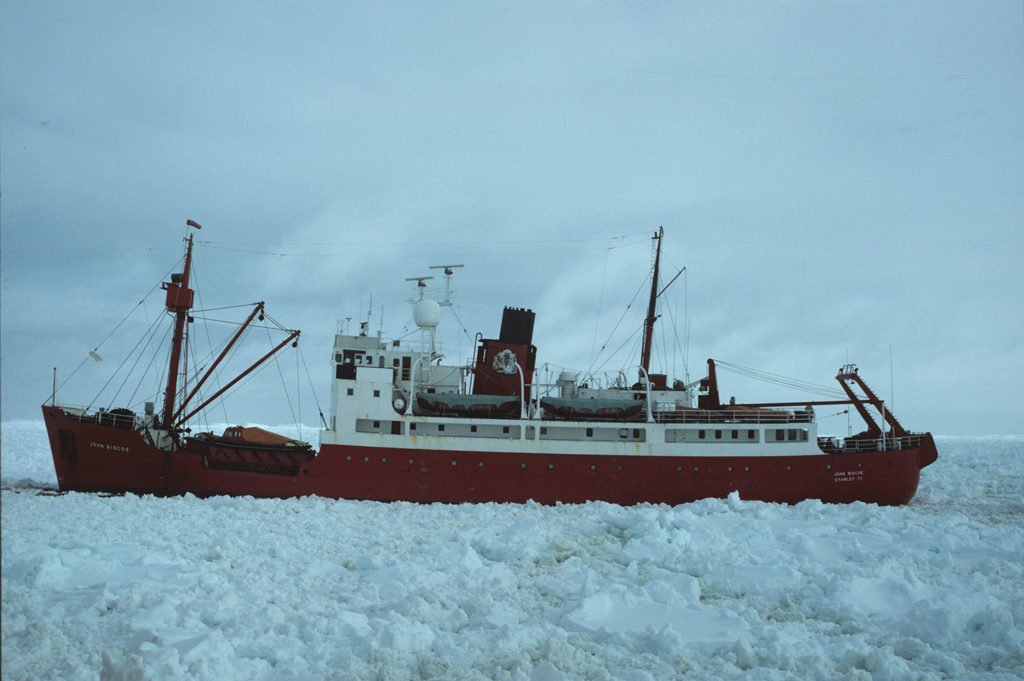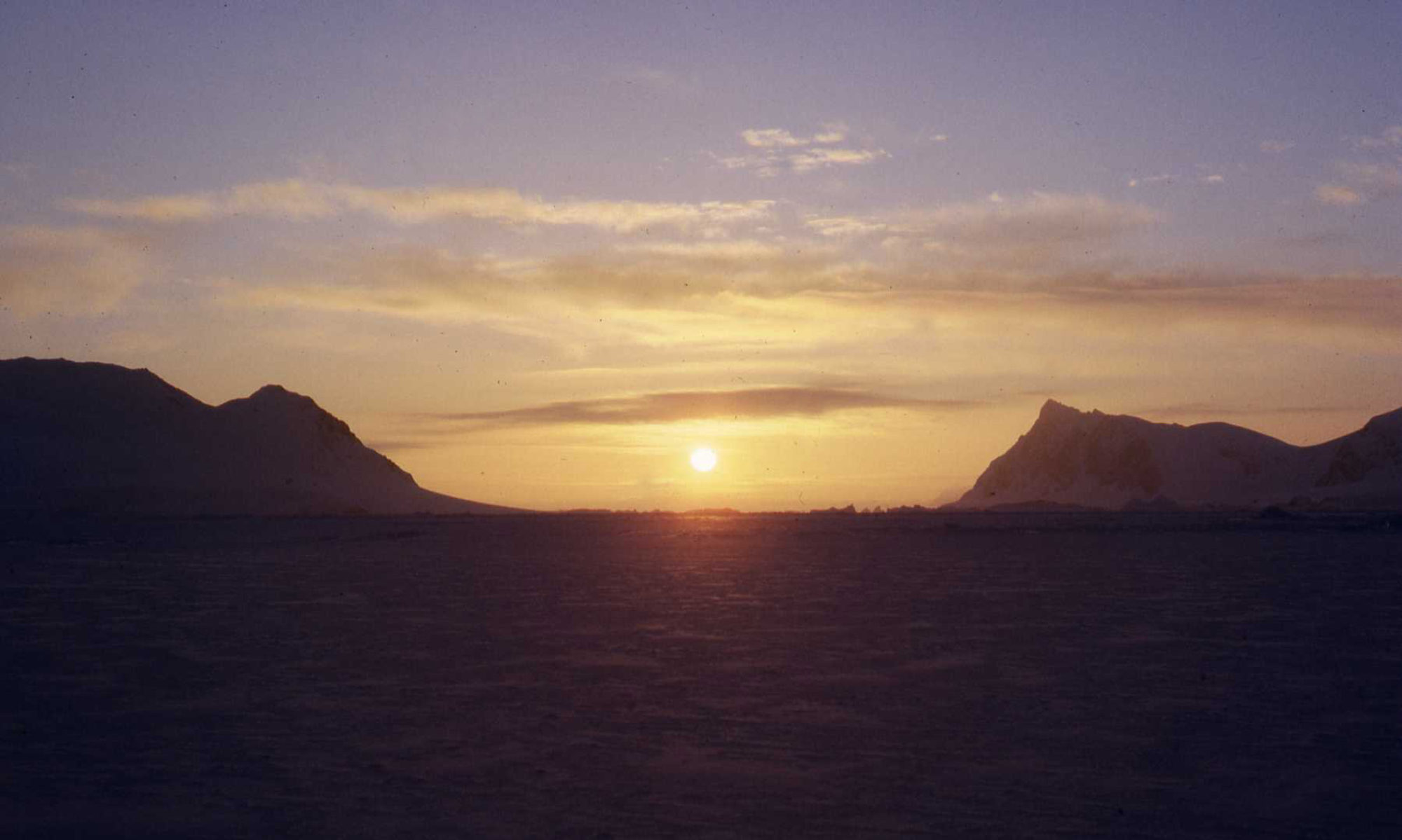“Abandon Ship” – in the Antarctic (continued)
The ship charges at the ice, make a few 10s of metres progress but the windblown ice immediately closes in around the stern so we can’t back up. After a while, further efforts were futile so the engines were switched off. We were stuck in the ice. From time to time a Twin Otter would fly overhead and suggest a possible lead which the ship tried – without much success. . This all went on for quite a while – days and days in fact. We had first entered the ice on the 10th November and were still in it on the 17th! We then called for assistance and the American ship “Polar Duke” headed towards us – same size as the Biscoe but 3 times the engine power. In due course she arrived and circled round us trying to break up the ice and carve a channel for us. But to no avail.
On the evening of the 17th November some concern was being expressed about a big tabular berg about 5 miles away and being blown towards us…… A rough estimate of the mass was 15,000,000 tonnes. By the time everyone turned in it was less than a mile away.

(Photo: Jonathan Walton)
The following day the weather turned for the worse. The Northerly wind had strengthened packing the ice ever more densely together. We all breathed a sigh of relief when the big berg missed us – but only by 300m! The problem was that the increased wind meant that the ship was now drifting across the surface – towards the Amiot Islands which had underwater reefs.

We were all asked to gather in the canteen at 1720 for an announcement. There we were told to get dressed warmly, fill one kitbag each of personal equipment and be ready to abandon ship in 30 minutes. On being given this news there was a stunned silence and jaws hit the floor. But that is indeed what happened. Polar Duke steamed to within about 20metres of the Biscoe, a line of wooden pallets was laid across the ice and one by one we climbed down a rope ladder, walked across the pallets and climbed on to Polar Duke. All very subdued. We all felt for Chris Elliott, our Captain. Surely the worst thing a ship’s captain could ever have to do is to order “Abandon Ship”.
The only light moment in all this was when Polar Duke enquired how many there were on board our ship. When told the number, around 60, there was a moment’s silence then a statement that – “in that case, can you bring some food with you – there are only 12 crew on Polar Duke!”.

We steamed away with a great feeling of sadness – would we ever see the Biscoe again? It was estimated that at the present rate of drift, the ship would strike within about 90 minutes. Chris had ordered the anchor to be lowered with maximum chain in the hope that it might catch and stop the ship moving any further. Many of us shed tears.
Our rescuer’s vessel had no great problems with the consolidated brash and it was not long before we were back in the open sea. The increased wind had produced impressive seas – I remember a very uncomfortable night. Bodies were distributed everywhere – the largest dormitory was in the hold!
The following morning saw a lot of rather ill FIDs moving around after a rough night. Around the middle of the day the enormous German Icebreaker Polar Stern came close and Chris Elliott and 5 members of the Biscoe’s crew were transferred aboard – they then headed back south to see if our old friend could be retrieved. The wind had changed direction – perhaps the direction of drift had changed too!
BAS of course had issued a Press release and were systematically contacting all the next of kin to let them know details and assure them that everyone was safe and well. My wife, Wendy-Jane, hadn’t heard anything about the incident by the time the BBC 6pm news came on the TV – she was seated having her supper in the doctor’s mess at the hospital where she was working. When the event was reported she evidently said some words she was later a bit embarrassed about before going back to work. 15 minutes later she received a phone call from Cambridge to assure her that I was fine.
Meanwhile Polar Duke duly discharged a ship load of refugees at Palmer Station. We decided we were probably the most southerly group of “boat people” in the world – at that stage the news was full of Vietnamese boat people trying to flee that country.
American hospitality at Palmer station was fabulous. A massive party and after the worries of the past days the alcohol on offer was eagerly consumed. I well remember getting up the following morning and walking into the main party area to see a sea of sleeping FIDs and ship’s crew – with the Television still on. I won’t say what was being screened!
And then, in the space of 24 hours, our world righted itself again and all news was good. The change of wind had freed up the ice around the John Biscoe, she hadn’t hit any underwater obstacles, the skeleton crew had been put aboard, had started the main engines without difficulty, had raised the anchor and had driven into clear water. She had been retrieved! Not only that but the weather had improved a lot; Two Twin Otter aircraft had flown up from Rothera, landed on the snow strip above Palmer Station and less than 24 hours after arriving at Palmer 16 of us had been transferred to Rothera! What a difference a day makes!!!!!
What did we all learn from this. New FIDS had a baptism by fire and old FIDs had a reminder of how the weather in the Antarctic controls everything. We were let off lightly – it was as if someone up very high had decided that we were getting a bit uppity and needed to be brought down a peg or two. But then relented and let us off with just a caution. We learned – or relearned – a lesson – never ever take the Antarctic for granted!
